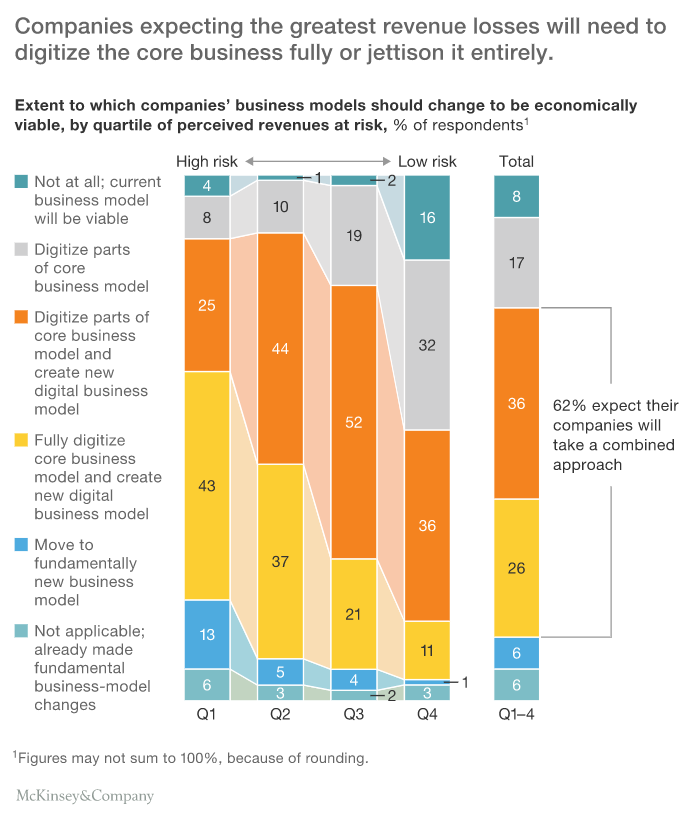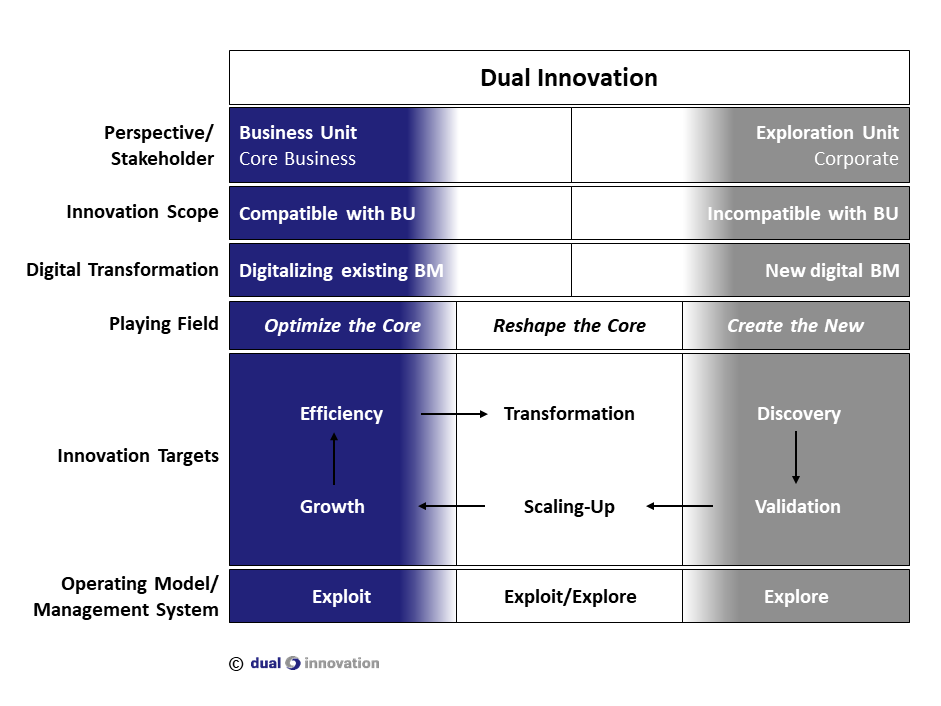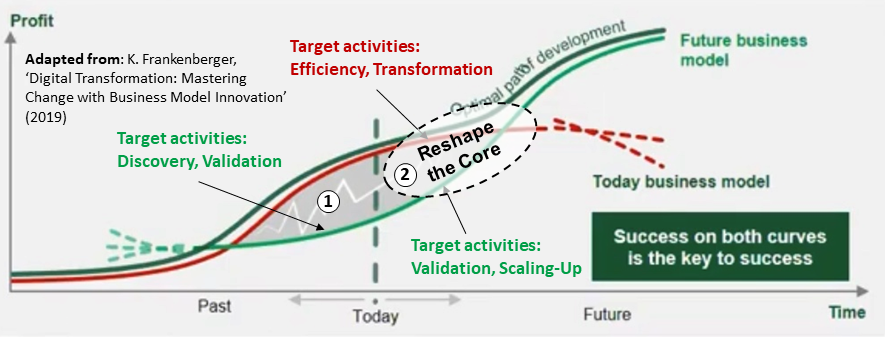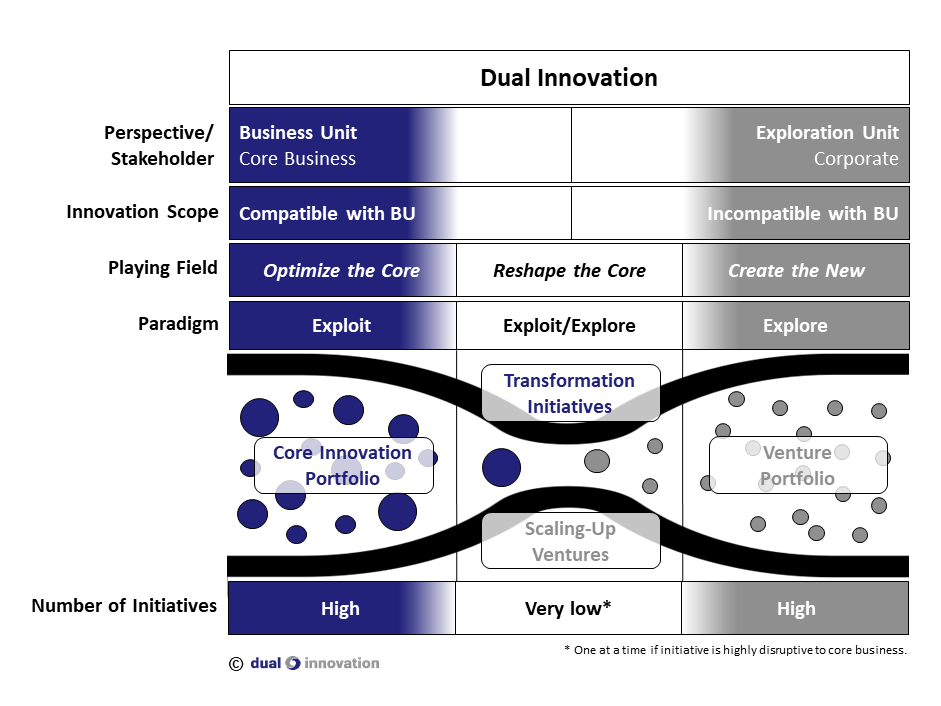Recently, Karolin Frankenberger from University of St. Gallen gave a worthwile presentation, one chart of which neatly illustrates why Dual Innovation is essential nowadays: Digitally transforming a company calls for true ambidexterity, i.e. simultaneously succeeding on the S-curve of today’s business model AND that of the future business model which is supposed to eventually supersede the existing one. This dual approach to business model innovation is most likely the greatest challenge companies’ CEOs are facing these days. In their work, Frankenberger et al. refer to this as The Transformer’s Dilemma.
Digitally adapting and prolonging existing business models involves creating digital or digitally-enhanced offerings, digitizing the operating model and its backbone processes, improving the digital customer experience, adapting the commercial model and increasing overall efficiency (Defense). In contrast, inventing a future, natively digital business encompasses developing an entirely new digital (e.g. platform-based) business model which ideally enables exponential growth, and defining an appropriate role for the company therein (Offense).
A recent study from McKinsey revealed that 62% of the survey respondents – in average and across industries – have expected their companies to adopt a dual approach to Digital Transformation. This is true even for respondents reporting the highest levels of revenues at risk, though tackling both the core business and new business models typically involves a more complicated strategy and operating model than focusing on one or the other.

What are companies that consistently embrace digital change doing differently? The study further indicates that those Digital Reinventors are all outperforming their non-digital peers in revenues and earnings. The practices of the reinventors differ from those of traditional incumbents in three critical areas:
- Approach to investments: Digital Reinventors are likelier to invest more – and bolder – in Digital than traditional incumbents are. The percentage of annual revenues invested by incumbents playing digitally (which have the greatest market share) is more than three times as high as that of traditional incumbents.
- Degree of innovation: Digital Reinventors are at least twice as likely as traditional incumbents to report modifying their long-term strategies in response to digital-related changes. Moreover, they are much more likely than their peers to have launched new businesses and to have built new digital business models. Most notably, they are almost seven times more likely than their traditional counterparts to have fully digitized their core business models.
- Application of digital technologies: Digital Reinventors are more likely to use cutting-edge digital technologies – and to use them at scale – than are their counterparts, which tend to spread investments thinly across technologies, without scaling them up.
The Digital Reinventors appear to be using these practices both to digitally transform their core businesses and to grow new digital businesses.
Ownership and accountability for coming up with new business models are (ideally) assigned to a dedicated unit which we typically name Exploration Unit in our work. It is organizationally separated from core business units that own the existing business models, yet operates at eye level with them. The reason behind, as we have frequently pointed out: Optimizing/extending existing businesses (Exploit) and validating/growing new ones (Explore) build on disparate, virtually incompatible paradigms and management systems. Let’s bear in mind: Systems do not collaborate!
As delineated in the table below, businesses in a corporate setting traverse a sequence of innovation targets along their life cycle: Discovery – Validation – Scaling-Up – Growth – Efficiency – Transformation.
- Discovery and Validation of new business models should be driven by the Exploration Unit and be run on an Explore-paradigm. (Create the New)
- Growth and Efficiency are typically pursued by the Business Units which operate the established business models and build on an Exploit-paradigm. (Optimize the Core)
- Scaling-Up of new business models and Transformation of existing business models (which essentially involves Digitalization) require a blend of Explore and Exploit as those activities operate at the interface of both paradigms. (Reshape the Core)
Create the New and Optimize the Core activities can be run independently from each other by the corresponding organizational units as they can be regarded Explore- and Exploit-only, respectively. By contrast, Reshape the Core activities call for
- close collaboration and capability exchange between Exploration Unit and Business Unit(s).
- sustainable integration of the disparate Explore and Exploit management systems/operating models across their dimensions – such as mandates/objectives, leadership/governance, metrics, resource access, organizational structures/processes or culture.
When it comes to replacing an existing (digitalized) business model by a new (digital) one, attuning both S-curves proves key. If the simultaneous work on both curves (grey-colored area in the adapted chart from K. Frankenberger below) is roughly divided into two parts, the ‘later stage’ (2) combines Validation and Scaling-Up of the new business model with Efficiency and Transformation of the existing one.
Specifically, the intersection of both curves, that characterizes the overtaking of the old by the new business model is determined by a
- Transformation phase: protecting and prolonging the existing business model by (digitally) adapting it.
- Scaling-Up phase: growing the new (digital) business model up to a sizable business which carries the potential to financially compensate the breaking away old business model.
An optimal overall path of development is passed through if the life cycle of the existing business model can be extended and stabilized, while the new business model is scaled up quickly.
As can be taken from the following table, Transformation and Scaling-Up initiatives reshape the core by
- operating at the interface of corporate Exploit and Explore environments.
- engaging collaboration between Business Unit(s) and Exploration Unit.
- exchanging explorative and exploitative capabilities, i.e. Transformation initiatives selectively draw on the Exploration Unit’s competence in emerging technologies, business building and innovation methodology – while Scaling-Up ventures leverage core business capabilities for unfair advantage, such as customer access, SCM/operations or brand image.
Therefore, Reshape the Core activities demand a dedicated corporate environment (Playing Field) that meets these requirements, thereby providing an adequate organizational interface between Explore management system/Exploration Unit and Exploit management system/Business Unit. Due to their disruptive potential to the broader organization, Transformation and Scaling-Up initiatives should be kept very low in number – occasionally one at a time, focusing on either Transformation (Defense) or Scaling-Up (Offense).
Takeaway
Digital Transformation of companies comes in large part down to managing a dual approach to business model innovation: protecting and adapting the existing business model through Digitalization vs. validating and growing a new digital business model. Properly attuning Defense and Offense, and thus ensuring an optimal replacement of the existing by the new business model, hinges on two innovation key activities: Transformation and Scaling-Up. Both activities draw on a blend of Exploration and Exploitation in respect to the needed capabilities and the underlying mode they are managed.
Acting truly ambidextrous and getting the critical business model transition phase right requires having a dedicated environment for these key activities in place. Here, Explore and Exploit connect and the corresponding organizational units collaborate. An interfacial environment and the corresponding capability proves vital for a company’s long term success. Adequately designing this intermediate, still widely disregarded Playing Field to successfully Reshape the Core is at the heart of our proposed Dual Innovation approach.












No comments yet.